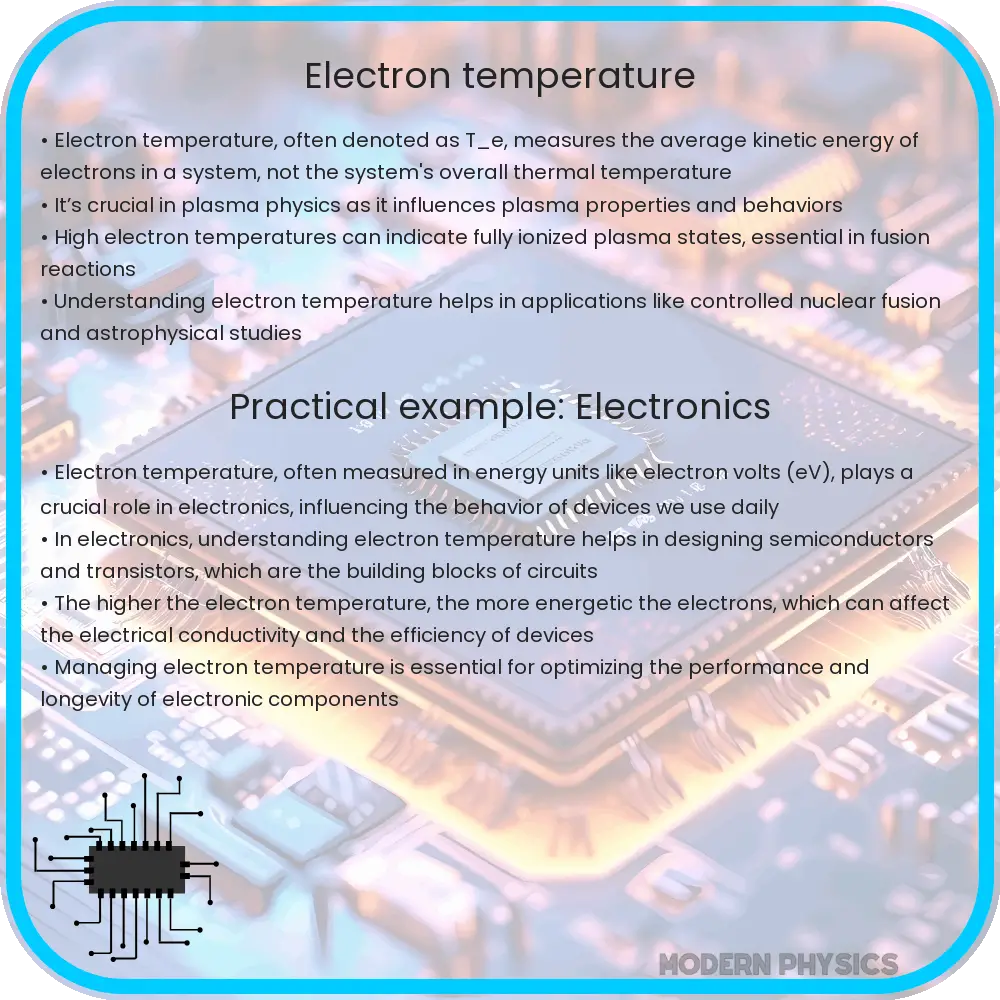Explore the significance of electron temperature in plasma diagnostics, its measurement techniques, and its crucial role in energy generation and astrophysical studies.

Understanding Electron Temperature in Plasma Diagnostics
Plasma diagnostics is a crucial area of research in understanding the behavior of ionized gases, which are essential in various fields, including energy generation, astrophysics, and controlled nuclear fusion. One of the fundamental parameters in plasma research is the electron temperature, a measure that significantly influences plasma’s physical and chemical properties.
The Significance of Electron Temperature
Electron temperature, often denoted as Te, is a key indicator of the energy state of electrons within a plasma. Unlike conventional temperature measurements, which imply a uniform energy distribution among all particles, Te specifically refers to the kinetic energy distribution of electrons. This distinction is crucial because electrons, due to their lower mass compared to ions, can achieve higher energy levels and therefore dominate the plasma’s reaction rates and electrical properties.
Measuring Electron Temperature
To accurately gauge Te, scientists employ various diagnostic techniques, each with its unique advantages and limitations. Some of the most common methods include:
- Langmuir Probes: These devices, inserted directly into the plasma, collect current-voltage characteristics to derive the electron temperature. Langmuir probes are widely used for their simplicity and direct measurement capabilities.
- Spectroscopy: This method analyzes the emitted light from plasma to infer Te. By examining specific spectral lines and their intensities, researchers can estimate the energy levels of electrons.
- Thomson Scattering: A non-intrusive technique that scatters laser light off the plasma’s electrons to determine their temperature. Thomson scattering is highly accurate but requires sophisticated equipment.
Applications and Challenges
Understanding electron temperature is vital for the development of energy systems, especially in the pursuit of controlled nuclear fusion. High Te values are indicative of plasma capable of sustaining fusion reactions, a holy grail for clean energy researchers. However, accurately measuring and controlling Te presents significant challenges due to the complex nature of plasma behavior, requiring ongoing advancements in diagnostic technologies and theoretical models.
Advancements in Electron Temperature Diagnostics
Recent advancements in plasma diagnostics have focused on improving the accuracy and reliability of electron temperature measurements. Innovations in laser-based diagnostic techniques, such as Thomson scattering, have enhanced the spatial and temporal resolution of Te measurements. Additionally, developments in computational plasma physics have enabled more sophisticated modeling and simulation tools, providing deeper insights into plasma behavior and assisting in the interpretation of experimental data.
Energy and Theory: The Role of Electron Temperature
In the context of energy generation and plasma theory, the electron temperature plays a pivotal role in determining the feasibility and efficiency of plasma-based processes. For instance, in fusion energy research, achieving and maintaining the optimal Te is critical for initiating and sustaining fusion reactions. Similarly, in space and astrophysical plasmas, understanding Te helps in deciphering the dynamics of solar flares, interstellar medium, and other cosmic phenomena.
Challenges in Electron Temperature Control
Despite significant progress, controlling electron temperature in practical applications remains a formidable challenge. In fusion reactors, for example, maintaining the delicate balance of Te necessary for efficient fusion reactions requires precise control over plasma confinement and heating mechanisms. Additionally, the interaction of plasma with reactor materials introduces further complexity, potentially affecting the stability and uniformity of Te.
Conclusion
The study and management of electron temperature are at the core of plasma diagnostics, offering profound implications for energy generation, astrophysics, and beyond. As we advance our understanding and technological capabilities, the precise measurement and control of Te continue to be a focal point of research. The challenges associated with electron temperature in plasma highlight the need for ongoing innovation in diagnostic methods and theoretical models. Through dedicated research and development, the potential of plasma-based technologies, especially in the realm of clean and sustainable energy, can be fully realized, marking a significant stride towards harnessing the power of plasma for the betterment of humanity.
